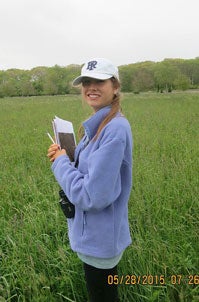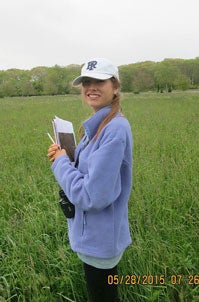 KINGSTON, R.I. – January 6, 2016 – University of Rhode Island junior Charlotte Steeves has always had a strong connection to the natural world and a desire to protect it. The conservation biology major did just that as a URI Coastal Fellow, recently completing a six-month project to study and monitor grassland-nesting birds in an effort to improve their chances of survival in southern New England.
KINGSTON, R.I. – January 6, 2016 – University of Rhode Island junior Charlotte Steeves has always had a strong connection to the natural world and a desire to protect it. The conservation biology major did just that as a URI Coastal Fellow, recently completing a six-month project to study and monitor grassland-nesting birds in an effort to improve their chances of survival in southern New England.
A resident of Pepperell, Mass., Steeves said that birds like bobolinks and savannah sparrows nest on the ground in overgrown agricultural fields, where their nests are often destroyed when farmers use tractors to cut hay in the fields.
“The haying happens during the prime nesting season for the birds, which is why the birds are declining annually at greater than 2.5 percent,” she said. “When the farmers mow their fields before the birds have a chance to finish raising their young, the nests get mowed over and the babies are killed.”
So Steeves partnered with the Dartmouth Natural Resource Trust to monitor a 26-acre field it owns. Her goal was to determine where most of the birds were believed to be nesting and which 10-acre parcel could be mowed by a local farmer.
“My job was to survey the field every morning to determine the areas of highest bird activity, and that data was used to determine which 10 acres to set aside for the farmer,” Steeves said. “It turned out that the areas with the thickest grass were where most of the birds were found.”
Thanks to her efforts, Steeves helped two pairs of bobolinks and at least three pairs of savannah sparrows successfully raise their young.
“By mid-June, the grass was taller than me, and the birds were elusive and remained hidden,” she said. “When I went into the grass, the parents would freak out, so that’s how I knew they were on their nests. By July, I saw little fledglings venturing outside of their nests.”
The URI student hopes the Natural Resource Trust can use the same methods next year to decrease the mortality rate of the two species and grow the population of the birds in the area.
Steeves’ research was supported by the URI Coastal Fellows program, a unique initiative designed to involve undergraduate students in addressing current environmental problems. Now in its 20th year, it is based at URI’s College of the Environment and Life Sciences. Students are paired with a mentor and research staff to help them gain skills relevant to their academic major and future occupations.
“The program really helped me decide that this kind of research is something I definitely want to pursue in the future – not necessarily birds, but the methods I used to monitor them could be used for other kinds of wildlife,” said Steeves, whose program mentor was URI Professor Peter Paton. “Before this project, I didn’t really know how to analyze data to understand patterns and trends. It was a great experience.”
When Steeves graduates from URI in 2017, she plans to attend graduate school to earn a master’s degree in conservation biology, and she may also pursue a degree in hydrology, a discipline she fell in love with thanks to a URI class taught by Professor Arthur Gold. Ultimately she wants to follow in the footsteps of her father, who uses Geographic Information Systems (GIS) to study watersheds for the U.S. Geological Survey.
“I want to use GIS to track populations of different species and use that information to determine the best way to manage those populations and protect them from human development,” Steeves said. “I want to dedicate my life to protecting the natural world.”
(Photo provided by Charlotte Steeves)

